Coral reef discovered off Greenland

By sheer coincidence, Canadian researchers have discovered a reef of living cold-water corals in southern Greenland. PhD student Helle Jørgensbye from DTU in Denmark has been investigating the reef further
The first ever Greenlandic reef is located in southwest Greenland and was formed by cold-water corals with hard limestone skeletons. There are several species of coral in Greenland, but this is the first time that an actual reef has been found.
In the tropics, reefs are popular tourist destination for divers, but there is little prospect of Greenland becoming a similar diving hotspot. The newly discovered living reef is located off Cape Desolation south of Ivittuut, and lies at a depth of 900 metres in a spot with very strong currents, making it difficult to reach. This also means that so far little is known about the reef itself and what lives on it
The reef was discovered by accident when a Canadian research vessel needed to take some water samples. When the ship sent the measuring instruments down to a depth of 900 metres, they came back up completely smashed. Fortunately there were several pieces of broken coral branches on the instrument that showed what was responsible.
"At first the researchers were swearing and cursing at the smashed equipment and were just about to throw the pieces of coral back into the sea, when luckily they realised what they were holding," says PhD student Helle Jørgensbye, DTU Aqua, who does research into life at the bottom of the west Greenland waters.
The first photos

Another Canadian research vessel returned to the site last fall to try and lower a camera down onto the reef to explore it close up. The coral reef is on the continental shelf itself where it is very steep and where there are strong currents.
"We got some photos eventually, although we almost lost them at the bottom of the ocean as the camera got stuck fast somewhere down in the depths. Luckily we managed to get it loose again and back up to the surface," says Helle Jørgensbye.
"It's been known for many years that coral reefs have existed in Norway and Iceland and there is a lot of research on the Norwegian reefs, but not a great deal is known about Greenland. In Norway, the reefs grow up to 30 metres high and several kilometres long. The great Norwegian reefs are over 8,000 years old, which means that they probably started to grow after the ice disappeared after the last ice age. The Greenlandic reef is probably smaller, and we still don't know how old it is," says Helle Jørgensbye, expressing the hope that at some point this will be investigated more closely.
According to Helle Jørgensbye, finding a coral reef in southern Greenland was not entirely unexpected:
"There are coral reefs in the countries around Greenland and the effect of the Gulf Stream, which reaches the west coast, means that the sea temperature get up to about 4 degrees, which is warm enough for corals to thrive. In addition to the, for Greenland, comparatively warm temperature, a coral reef also needs strong currents. Both these conditions can be found in southern Greenland," she says.
Coral reefs are important areas for fish because it provides masses of food and lots of hiding places for fish fry. The Greenlandic reef is formed from Lophelia stoney corals. Other species of coral are also found in many parts of the west coast. However, they are all 'stand-alone' corals and do not form reefs. The identification of the Lophelia specimen was carried out by Professor Ole Tendal from Denmark's Natural History Museum.
Cold Water Corals
Normally, coral reefs are associated with the tropics, but they are also found in cold waters. While the tropical coral reefs depend on light to survive, cold-water coral reefs live in total darkness, at depths the sun's rays never penetrate. Nevertheless, they have many colourful residents and many different kinds of organisms living in them.
Coral reefs are built up of thousands of small coral animals that live in a large colony which forms a common limestone skeleton. While hot water corals obtain some of the energy they need to grow from the light-dependent green algae which live in the corals, cold water coral get all their nourishment from small animals, which they catch. Thus, they are not dependent on light and can live in very deep water
Provided by Technical University of Denmark
















